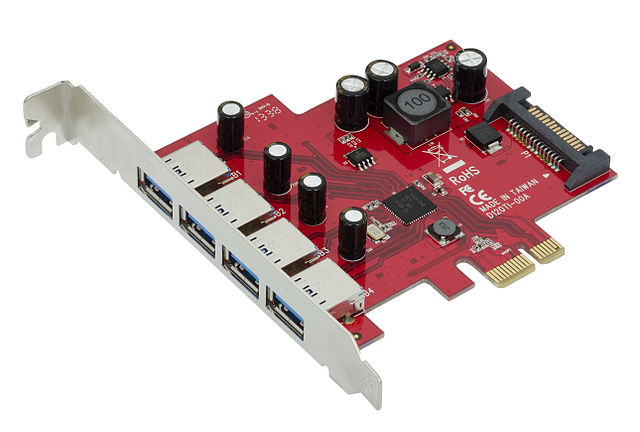Universal Serial Bus 3.0, marketed as SuperSpeed USB, is the third major version of the Universal Serial Bus (USB) standard for interfacing computers and electronic devices. It was released in November 2008. The USB 3.0 specification defined a new architecture and protocol, named SuperSpeed, which included a new lane for a new signal coding scheme providing full-duplex data transfers that physically required five additional wires and pins, while preserving the USB 2.0 architecture and protocols and therefore keeping the original four pins and wires for the USB 2.0 backward-compatibility, resulting in nine wires in total and nine or ten pins at connector interfaces. The new transfer rate, marketed as SuperSpeed USB (SS), can transfer signals at up to 5 Gbit/s with nominal data rate of 500 MB/s after encoding overhead, which is about 10 times faster than High-Speed. USB 3.0 Type-A and B connectors are usually blue, to distinguish them from USB 2.0 connectors, as recommended by the specification. and by the initials SS.

Front view of a Standard-A USB 3.0 connector, showing its front row of four pins for the USB 1.x/2.0 backward compatibility, and a second row of five pins for the later (but out-of-date) USB 3.0 connectivity. The plastic insert is in the USB 3.0 standard blue color, Pantone 300C.
Internal circuitboard and connectors of a USB 3.0 four-port hub, using a VIA Technologies chipset
A USB 3.0 controller in form of a PCI Express expansion card
Side connectors on a laptop computer. Left to right: USB 3.0 host, VGA connector, DisplayPort connector, USB 2.0 host. Note the five additional pins on the underside of the tongue of the USB 3.0 port.
Universal Serial Bus (USB) is an industry standard that allows data exchange and delivery of power between many types of electronics. It specifies its architecture, in particular its physical interface, and communication protocols for data transfer and power delivery to and from hosts, such as personal computers, to and from peripheral devices, e.g. displays, keyboards, and mass storage devices, and to and from intermediate hubs, which multiply the number of a host's ports.
Various legacy USB and related connectors (left to right): USB Micro-B plug, proprietary UC-E6 plug, USB Mini-B plug, Standard-A-like receptacle (non-compliant), Standard-A plug, Standard-B plug. Shown with a centimeter ruler.
USB logo on the head of a standard Type-A (Standard-A) plug
A USB 2.0 PCI expansion card
USB 3.2 Gen 1(x1), Standard-A connectors labelled as USB 3.1 Gen 1 – originally simply named USB 3.0 and marketed as SuperSpeed USB (by USB 3.0 specification) and later named as USB 3.2 Gen 1x1 and marketed as SuperSpeed USB 5Gbps by the USB 3.2 specification








